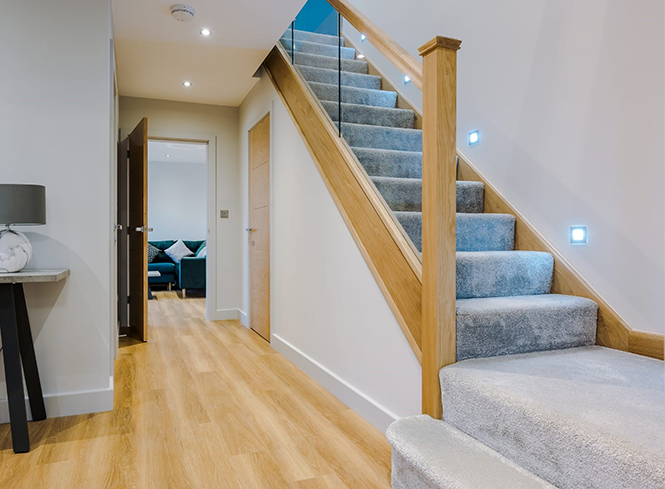Maine Stair Company Wins People’s Choice Award
We’re excited to congratulate Maine Stair Company on winning Best Curved Stairway – Artisan and the People’s Choice Award at this year’s SMA Annual Conference and Staircraft Awards Competition! […]
Joinery company Alan Grice has combined half a century of knowledge and craftsmanship with modern design and production techniques through Staircon software, improving customer relationships and taking its staircase manufacturing capabilities to a new level.

Alan Grice has been manufacturing timber staircases and bespoke joinery for more than 40 years from its headquarters in Lancashire, UK.
A family-run business, its highly regarded reputation was built on traditional workshop techniques. But three years ago, Alan Grice decided to modernise its approach to staircase production.Investing in a HOMAG 5-axis CNC machine and Staircon by Elecosoft has brought the company’s design and manufacturing capabilities into the 21st century.
Since then, Alan Grice has been able to take on ambitious, high value projects previously beyond the company’s reach, without compromising on either product quality or profit margin.
Bespoke designs, precision craftsmanship
After making its name manufacturing staircases for major housing developers, Alan Grice moved away from mass production following the 2008 recession. The company now focusses on turnkey projects for private developers, new home builders, and families extending or converting their homes.
“We were forced into bespoke commissions when the commercial housing market dried up. However, we quickly realised that we preferred this type of work,” shares Jason Grice, Company Director at Alan Grice. “We pride ourselves on delivering a high standard of work and we didn’t want to be put under pressure to reduce costs or stick to minimum material requirements any longer.”
Every staircase design was hand drawn at this point and the whole process was managed on paper, with pricing calculated using an Excel spreadsheet. As the company evolved, Alan Grice wanted a quick, reliable, and accurate way of translating customer visions through precision craftsmanship.
“When you hand draw designs, they are always open to interpretation in the workshop. We wanted to remove that ambiguity, so our customers could see exactly what they were getting before their staircase went into production,” Jason explains.
Making an investment for the future
To bring its design and manufacturing operation up to date, Alan Grice invested in a HOMAG CENTATEQ P-300 5-axis CNC machine and Staircon CAD/CAM software in 2018.
“It was a bold move for us to invest in the full 5-axis as our first CNC machine, but we wanted something that would serve our business for a long time. And it was exactly the same with Staircon,” Jason notes.
“We looked at a few software companies, but Staircon was the stand-out. It was really user-friendly, and it could deliver the long-term value we needed to grow over the next 15-20 years.”
Giving customers a clear vision
Unusually, the Alan Grice team started using Staircon several months before its CNC machine was delivered, using its design capabilities to help customers visualise exactly what their staircases would look like.
“Our staff were quick to embrace Staircon. There was no resistance – even though we’d been doing things the old way for many years – because the software is so impressive,” Jason praises.
“The visual capabilities of Staircon are unbelievable. We can create 3D visuals and spin them round to show the customer what their staircase is going to look like from every angle. They know exactly what they’re getting.”
Stepping up staircase design
In addition to impressing customers, Staircon’s digital design features have enabled Alan Grice to become more ambitious in the projects the company takes on.
“In the past, it would have been very difficult to manage the jobs we’re currently doing using traditional methods and timescales. Staircon has changed everything we can do; we don’t bat an eyelid when a new enquiry comes through that would have been difficult to produce in the past.”
Adopting CAD/CAM technology has also empowered the team to manage almost every element of the joinery process in-house, only using third party suppliers for steel and glass requirements. As a result, production changes can be made and replacement components created very quickly, reducing issues on installation.
“We don’t have to rely on partners or delivery companies; we can get things made and dropped off on site the same or the next day,” Jason shares.
Working together to innovate joinery
Starting with design and then exploring Staircon’s CAM capabilities has given Alan Grice a deep knowledge of the software, which it continues to explore in a collaborative relationship with Elecosoft’s Staircon support team.
“The software is in constant development, which is great for us. Elecosoft isn’t one of those companies that just says sorry, our technology doesn’t do that,” Jason shares. “If we’re struggling to do something the support team will help us to work around it, then feed that information back to Staircon’s developers. More often than not, a function that solves the issue will be added in the next upgrade.
“It’s a symbiotic relationship, and the upgrades we collaborate on are enabling us to grow our business.”
Tangible results and ROI
Since onboarding Staircon and its CNC machine, Alan Grice has significantly improved its service capabilities. The company is now:
Choose the best, achieve more
The Alan Grice team will continue to work closely with Elecosoft developing its use of Staircon software, with pricing integration next on the list. However, the company’s number one goal remains the same: to keep pushing the boundaries of staircase design and manufacturing.
“As far as we’re concerned, we’ve got the Mercedes-Benz of the CNC world and the Mercedes-Benz of the software world, and I’ve got no intention of ever moving away from Staircon,” Jason concludes. “We want to continue using it to do more unusual and ambitious work.”
Future-proof stair design and production. Book a free demo to explore Staircon by Elecosoft.